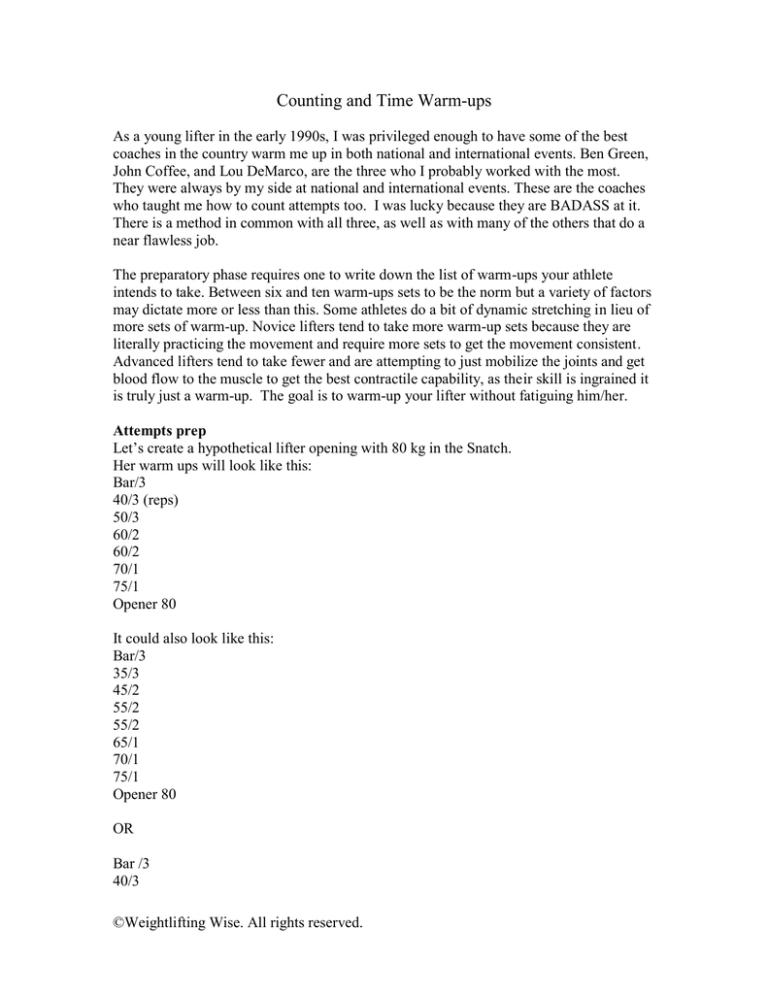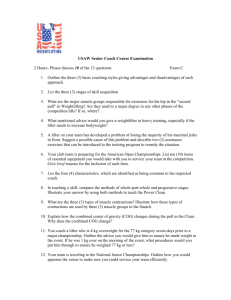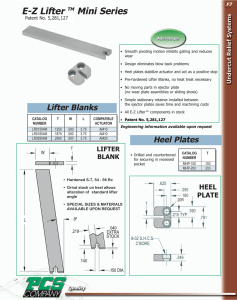
Counting and Time Warm-ups
As a young lifter in the early 1990s, I was privileged enough to have some of the best
coaches in the country warm me up in both national and international events. Ben Green,
John Coffee, and Lou DeMarco, are the three who I probably worked with the most.
They were always by my side at national and international events. These are the coaches
who taught me how to count attempts too. I was lucky because they are BADASS at it.
There is a method in common with all three, as well as with many of the others that do a
near flawless job.
The preparatory phase requires one to write down the list of warm-ups your athlete
intends to take. Between six and ten warm-ups sets to be the norm but a variety of factors
may dictate more or less than this. Some athletes do a bit of dynamic stretching in lieu of
more sets of warm-up. Novice lifters tend to take more warm-up sets because they are
literally practicing the movement and require more sets to get the movement consistent.
Advanced lifters tend to take fewer and are attempting to just mobilize the joints and get
blood flow to the muscle to get the best contractile capability, as their skill is ingrained it
is truly just a warm-up. The goal is to warm-up your lifter without fatiguing him/her.
Attempts prep
Let’s create a hypothetical lifter opening with 80 kg in the Snatch.
Her warm ups will look like this:
Bar/3
40/3 (reps)
50/3
60/2
60/2
70/1
75/1
Opener 80
It could also look like this:
Bar/3
35/3
45/2
55/2
55/2
65/1
70/1
75/1
Opener 80
OR
Bar /3
40/3
©Weightlifting Wise. All rights reserved.
40/3
50/2
60/1
60/1
65/1
70/1
75/1
Opener 80
We are essentially doing a percent progression of 50, 60, 70, 80, 90 but rounding to 5’s
and 10’s for the ease of loading. I have always preferred a couple of sets at about 70%
and then to move straight up doing only singles after that. The closer you get to the
heavier weights, the closer the jumps in weight are. The number of repetitions decreases
as we increase the intensity
My warm-ups have been:
Bar/3
35/3
35/2
45/2
55/2
55/1
60/1
65/1
70/1
75/1
Opener 80
Timing the warm-ups
Optimally you will have your lifter take their last warm-up attempt about 3 attempts or
minutes before their opening attempt. This will allow them three minutes of rest, as well
as time to take off extra articles of clothing, and mentally prepare without feeling rushed.
The next step is to determine how much time it will require for your lifter to warm-up.
SO you must consider how much time your lifter wants to rest between sets. The
conventional wisdom has been three minutes but I have found that I prefer 2 minutes in
the early sets and 3 minutes the last couple of warm-ups. I know many have become
accustomed to 3 minutes/attempts of rest. My opinion is that this is too much time for the
early warm-ups so I switched to 2. I have heard from some high level coaches that even 2
minutes is too much rest and depending on the lifter’s size and shape, it should be
adjusted. I agree. Larger lifters need more rest; smaller lifters less. Some lifters can’t sit
still once the process starts and so leaving them sitting may be undesirable. In the end,
you as the coach must learn about your lifter and then try to decide what is best.
Counting from the last warm-up I would then indicate the attempts/minutes out my lifter
is from their opener. The chart shows the count if there is 3 minutes/attempts between
each lift:
©Weightlifting Wise. All rights reserved.
Bar / 4
35 / 3
35 / 3
45 / 2
55 / 2
55 / 1
60 / 1
65 / 1
70 / 1
75 / 1
Opener 80
30
27
24
21
18
15
12
9
6
3
So every three minutes or attempts, I would need to take a lift and it is going to take 30
minutes/attempts for me to warm-up. Since I prefer less time between my early warmups, I will rest two minutes between my early sets and then go to three for last couple
sets. The chart below reflects that:
Bar x 4
22
35 x 3
20
35 x 3
18
45 x 2
16
55 x 2
14
55 x 1
12
60 x 1
10
65 x 1
8
70 x 1
6
75 x 1
3
Opener 80
This will change things significantly and now it will require only 22 minutes for me to
warm-up.
Checking the board or cards
Now the actual counting of attempts on the cards or board begins. The board will look
something like this:
Lot number
Lifter
Snatch 1st
attempt
87
43
64
69
78
80
54
A
B
C
D
E
F
G
62
70
75
75
80
80
84
©Weightlifting Wise. All rights reserved.
Snatch 2nd
attempt
Snatch 3rd
attempt
Best snatch
Counting attempts is (gu)estimating how many attempts there will before your lifter will
be called to the competition platform. There are two major aspects to consider: how many
lifts will go before you and the fifteen or ten minute clock. If your lifter is opening first,
their entire warm-up may be based on the clock (makes it easy but it means he/she is not
the strongest in the class!). I am lifter F. I would count 9 attempts will be taken on the
platform before I am called to lift. Lifter A will likely take all three of her attempts before
I start as will lifter B. It is likely also that there will be one or two clocks with lifter A
since a lifter who follows herself will get a two minute clock. This means I am going to
add two minutes/attempts to my calculation of 9, so I have 9 attempts plus 2 minutes, so I
will up the 9 to 11. She could actually have 2 two minute clocks between her 1 st and 2nd
attempts and possibly between 3rd and 4th if she is still below 70. There also could be a
miss/ repeat, or two adding in more time. It is unknown, until it happens. A lifter could
also move their opener up right as they are called out changing how many attempts there
are before me. So for example if lifter E changes her opener to 82, then I will be up one
earlier than I anticipated. It is important as a coach, you check out what’s happening on
the platforms as well as on the board to determine or guess if someone is going to raise
their opener.
So I had estimated 11 attempts before I will lift. And will have to also count using the
actual 15 minute clock. So I would start my warm-up attempts when the clock is at 11
minutes.
Bar / 4
35 / 3
35 / 3
45 / 2
55 / 2
55 / 1
60 / 1
65 / 1
70 / 1
75 / 1
Opener 80
22
20
18
16
14
12
10
8
6
3
11 minute
9 minute
7 minute
5 minute
3 minute
1 minute
10
8
6
3
So the bolded numbers are my counting of actual attempts and time once the meet has
started and the numbers labeled with the minutes indicate the time on the 15 minute
countdown clock. Note there is usually a 10 minute clock between snatch and clean and
jerk sessions. The introductions, which take a few minutes, are technically done AS the
15 minute clock runs. So as soon as I come from intros, I would expect the clock to be at
around 12 and when it reads 1, I need to take the set with the bar. Then, at 9 minutes take
35/3 ;at 7 minutes, 35 again; at 5 minutes, 45; and so on. Of course once the meet starts
there is no more countdown clock and I base my “minutes” on attempts. So as attempts
go I can count how many are still left to be taken until I open with 80.
©Weightlifting Wise. All rights reserved.
I am using red to indicate missed attempts and blue the announced attempt by the lifter,
black is for made attempts. A computerized board will have some way to distinguish
between these. It could be color, italics, bold, etc. In local meets it is sometimes a black
or eraser board and circled lifts are made and marked out weights are misses. Some basic
technical rules to know are 1st attempts at a weight go before second attempts at a weight
go before third attempts. The lifter with the larger difference in the weight from the
previous attempt goes first. So below, lifter B took 70 and called for 75; lifter C opened
with 75 but missed and will attempt it again on her second. Because there is a 5 kilo jump
for lifter B, she will go before lifter C. Lifter D will go before both of them since its her
first attempt. SO the order at 75 is lifter D, then B, then C. Whenever a lifter follows
herself, she gets a 2 minute clock.
Lot number
Lifter
Snatch 1st
attempt
Snatch 2nd
attempt
Snatch 3rd
attempt
Best snatch
87
43
64
69
78
80
54
A
B
C
D
E
F
G
62
70
75
75
80
80
84
65
75
75
65
65
Looking at the board now I (lifter F) could have as few as 4 attempts and as many as 6
before I am up. I notice that lifter B took a 5 kilo jump between attempts 1 and 3, so she
may do another 5kg jump. Lifter C just missed an opener. It’s a toss up but since I
decided it was an “ugly” miss (no chance in hell!) then she could potentially have 2 lifts,
and even a 2 minute clock if she misses again. The other lifters would have already made
it by that point. So I am going to count 5. I should have already hit my lift at 70 before
lifter C took 75 on her first attempt, that is when I was 6 out from my opener.
Lot number
Lifter
Snatch 1st attempt
Snatch 2nd attempt
Snatch 3rd attempt
Best snatch
87
43
64
69
78
80
54
A
B
C
D
E
F
G
62
70
75
75
80
80
84
65
75
75
77
65
80
77
65
So right now I (lifter F) am 3 attempts out and need to take my last warm-up of 75.
I was right about Lifter C not taking a 5 kg jump , She went to 77 and lifter D is up with
77 as well. If she misses, lifter C will take her third and then D will go again, so I’ll be
sitting at a solid three but there may be 4 if lifter D misses. Lifter E goes before me unless
she changes her opener. I can also look at the fact that lifter D only took a 2 kg jump and
wonder if she plans to go 79 instead of 80. Lot number decides who goes first on openers
if they are the same. The lower lot number opens before the higher lot number.
©Weightlifting Wise. All rights reserved.
Some things you can control and some things you cannot. Counting attempts is part
numbers game, part good guessing, part statistical chance, and part good observation. It
obviously helps if you know the lifters and their best lifts as well as their coaches’
patterns. You usually find out after the first session if the meet (loaders and announcers)
are moving fast or slow and can adjust for later session.
Hope this helps those who are learning to count attempts. My advice would be to shadow
someone who knows what they are doing to actually learn the ropes. Good luck!
If you questions don’t hesitate to contact me weightliftingwise@gmail.com
Train hard and train smart.
Weightlifting Wise
Ursula Garza Papandrea
©Weightlifting Wise. All rights reserved.



